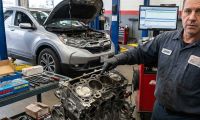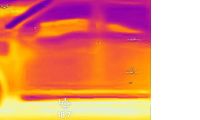Let's imagine a hypothetical model that Pratt outlines to Automotive News. In this model, there are 100 cars that emit 250g/km of CO2. With enough lithium to make 100 kWh of batteries, we could build one fancy electric car, like a top-spec long range Tesla. But what about the other 99 cars? They would still be using old-fashioned combustion engines and would emit CO2 just like before. This means that the fleet's CO2 figure would only decrease by a small amount, down to 248.5 g/km.
However, if we took that same 100 kWh of batteries and spread it out between 90 traditional hybrids, we would have a much bigger impact. With only 10 plain combustion cars left, the average emissions for the fleet would drop all the way down to 205 g/km!
This shows us that it is important to use our resources wisely and to find a balance between electric and traditional cars. By doing this, we can make a bigger impact in the fight against carbon dioxide emissions and make our world a better place.
Lithium Shortage: A Growing Concern for Electric Vehicle Adoption
The world is in a race to get more lithium, a key component in the batteries of electric vehicles. As demand for lithium increases, its prices are expected to go up too. This could limit access to battery packs for all vehicles, including electric ones.
The supply of lithium may only cover one-third of the global demand until 2040. This is well past the deadlines set by some car companies who plan to sell only battery electric vehicles (BEVs) by that time. The shortage of lithium could make it difficult for these companies to meet their goals and for consumers to have access to affordable electric vehicles.
This highlights the need for alternative sources of lithium or new technologies to be developed. The world must also find ways to efficiently use and recycle the limited lithium supplies to ensure its availability for the future. The race to get more lithium is not only a matter of competition, but also a matter of necessity for the transition to a cleaner and greener future.
Toyota's Diverse Approach to Carbon Neutrality
Toyota is taking a multi-faceted approach to reaching carbon neutrality and reducing emissions from its vehicles. The company recognizes that there is no one-size-fits-all solution, and so it is developing a range of electrified vehicles to meet the diverse needs of its customers.
Toyota offers a range of hybrid vehicles, which combine a conventional internal combustion engine with an electric motor. These vehicles offer improved fuel efficiency and reduced emissions compared to traditional gas-powered cars.
In addition to hybrids, Toyota is also investing in battery electric vehicles (BEVs). BEVs run entirely on electricity and produce no emissions while in use. Toyota is working to develop new BEV models that offer long driving ranges and affordable prices, making them accessible to a wider range of customers.
At the same time, Toyota is not abandoning traditional internal combustion engine (ICE) vehicles. Instead, the company is working to improve their efficiency and reduce their emissions. Toyota is using its expertise in advanced engine technology and lightweight materials to make its ICE vehicles as clean and efficient as possible.
By offering a range of electrified vehicles, Toyota is working to meet the diverse needs of its customers and make the transition to a cleaner and greener future. The company's approach to carbon neutrality is a testament to its commitment to sustainability and its belief in the power of diversity and innovation.
Seriously: what if we are wrong about an EV-only strategy?
Armen Hareyan is the founder and the Editor in Chief of Torque News. He founded TorqueNews.com in 2010, which since then has been publishing expert news and analysis about the automotive industry. He can be reached at Torque News Twitter, Facebok, Linkedin and Youtube.












Comments
You left out that Toyota also
Permalink
You left out that Toyota also has a hydrogen powered vehicle that uses a fuel cell. I'd buy one if there was a reliable supply of green hydrogen. (Five years ago I couldn't say that because I considered $50k too expensive. These days, $50k seems cheap.)
I think Toyota's approach is the correct one, and they'll reap the benefits when other manufacturers no longer have a diversified product line.
I'd consider a hydrogen
Permalink
In reply to You left out that Toyota also by bob E (not verified)
I'd consider a hydrogen powered vehicle if there was ANY general distribution system for hydrogen to refuel it. AFA "green hydrogen". The infrastructure to produce hydrogen cleanly or not requires electricity. The distribution system for electricity altready exists. The generation, distribution and staorage system for hydrogen doesn't.
SImilarly, BEV adoption will be constrained by after-sales support. Every machine needs service, and that will become Tesla's largest problem before 2030. It can't make metal cars cheap reliable and cheap enough for them to be disposible after a colision.
This extreme hypothetical
Permalink
This extreme hypothetical assumes many things that aren't true, but are relevant to environmental impact.
1. that the supply of lithium is limited and less than that needed to replace existing ICE vehicles at a replacement rate based on consumer need.
2 That existing manufacturers can produce cars at a rate that satisfies demand for replacement vehicles.
3. That those new vehices whether ICE or EV are affordable enoiugh that existjng ICE owners won't retain their existing vehicles much longer than before because the new vehicles are higher profit margin due to being loaded with "features' that aren't being asked for and objectvely aren't needed.
4. That new vehicles are similar in TCO and TEI (total environmenjtal impact) to existing ones - including the cost of repair after colisions and probability of being "titalled:" due to repair costs..
5. That lithium is required for EV batteries.
Since these real world factors aren't considered, the hypothetical case is irrelevant, and extermely biased.
If I had one cow and 100 people needed something to drink, is it better to give 30 people cows milk or have everyone drink less less milk and die of thirst? It's the same as the example. There are othet things that people can drink bedies mik.
There are other battery chemistries than lithium that can power cars.
There are vehicles other than the 100 year old "car" design that don't weigh 1000# +6x the weight of the cargo, and require smaller batteries than imagined only EV alternative.
The "problem" is that Toyota has no alternative to the ICE or ICE + motor generator that can be deployed with existing infrastructure, and is unable to conceive of rapidly converting its exsting production. Hopefully that will change before Japan is devasted by multiple annual floods, and its coast areas disappear.
It's true that there weill be a continued need for some specialty ICE and diesel vehicles, and adoption will be constrained by power infrastructure, but adoption will not be delayed because there is no supply of afiordable BEVs from companies unwilling to make them. If Toyota won't provide them, it will lose market share to those who will.